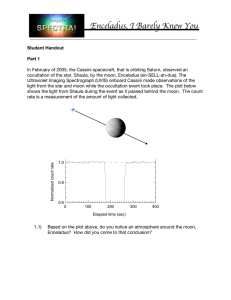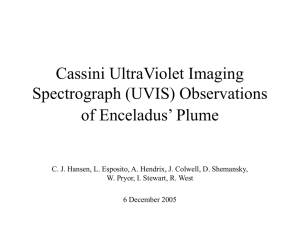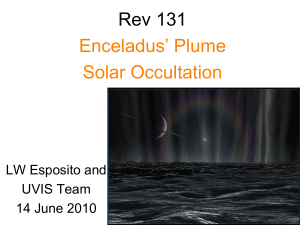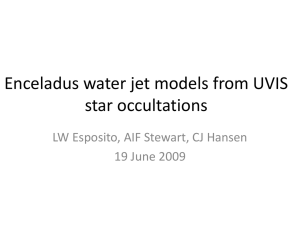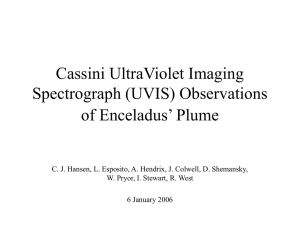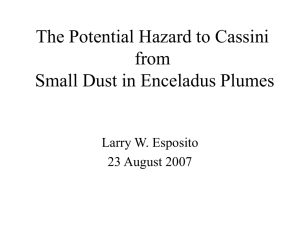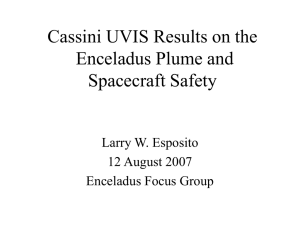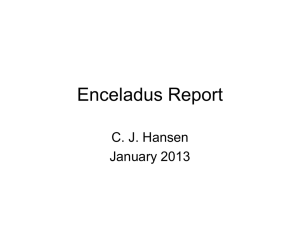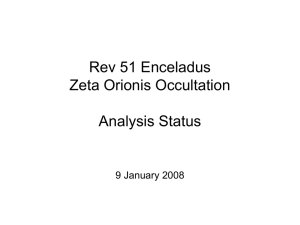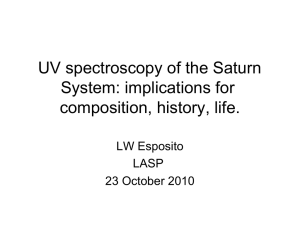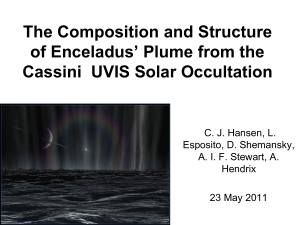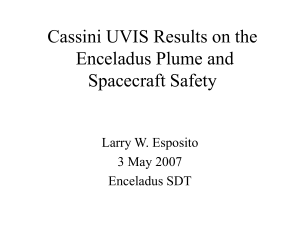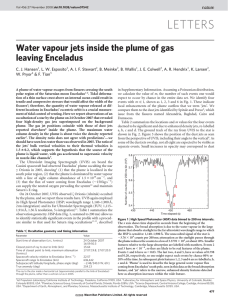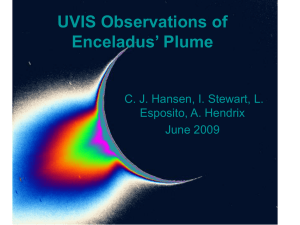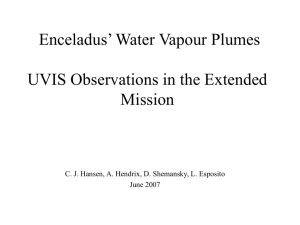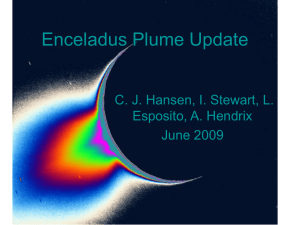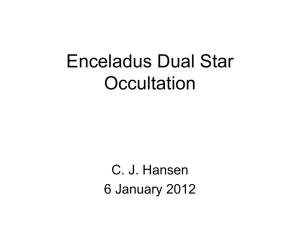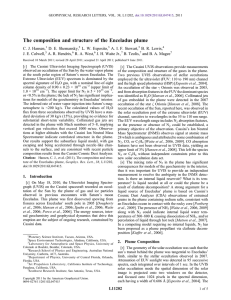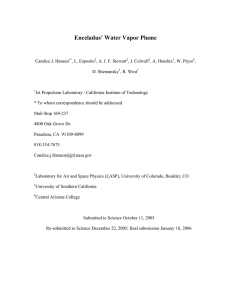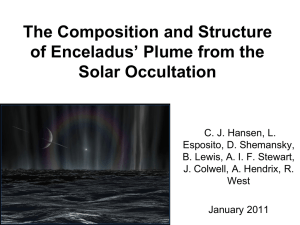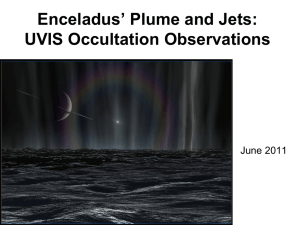Composition and Structure of Enceladus’ Plume from
advertisement
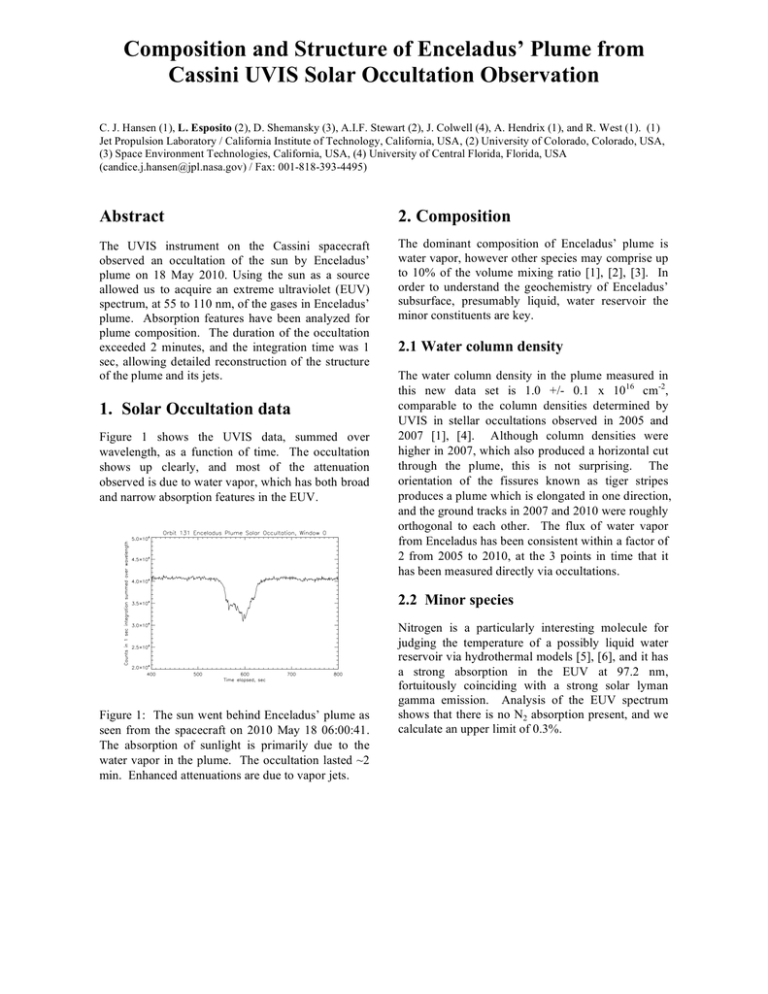
Composition and Structure of Enceladus’ Plume from Cassini UVIS Solar Occultation Observation C. J. Hansen (1), L. Esposito (2), D. Shemansky (3), A.I.F. Stewart (2), J. Colwell (4), A. Hendrix (1), and R. West (1). (1) Jet Propulsion Laboratory / California Institute of Technology, California, USA, (2) University of Colorado, Colorado, USA, (3) Space Environment Technologies, California, USA, (4) University of Central Florida, Florida, USA (candice.j.hansen@jpl.nasa.gov) / Fax: 001-818-393-4495) Abstract 2. Composition The UVIS instrument on the Cassini spacecraft observed an occultation of the sun by Enceladus’ plume on 18 May 2010. Using the sun as a source allowed us to acquire an extreme ultraviolet (EUV) spectrum, at 55 to 110 nm, of the gases in Enceladus’ plume. Absorption features have been analyzed for plume composition. The duration of the occultation exceeded 2 minutes, and the integration time was 1 sec, allowing detailed reconstruction of the structure of the plume and its jets. The dominant composition of Enceladus’ plume is water vapor, however other species may comprise up to 10% of the volume mixing ratio [1], [2], [3]. In order to understand the geochemistry of Enceladus’ subsurface, presumably liquid, water reservoir the minor constituents are key. 1. Solar Occultation data Figure 1 shows the UVIS data, summed over wavelength, as a function of time. The occultation shows up clearly, and most of the attenuation observed is due to water vapor, which has both broad and narrow absorption features in the EUV. 2.1 Water column density The water column density in the plume measured in this new data set is 1.0 +/- 0.1 x 1016 cm-2, comparable to the column densities determined by UVIS in stellar occultations observed in 2005 and 2007 [1], [4]. Although column densities were higher in 2007, which also produced a horizontal cut through the plume, this is not surprising. The orientation of the fissures known as tiger stripes produces a plume which is elongated in one direction, and the ground tracks in 2007 and 2010 were roughly orthogonal to each other. The flux of water vapor from Enceladus has been consistent within a factor of 2 from 2005 to 2010, at the 3 points in time that it has been measured directly via occultations. 2.2 Minor species Figure 1: The sun went behind Enceladus’ plume as seen from the spacecraft on 2010 May 18 06:00:41. The absorption of sunlight is primarily due to the water vapor in the plume. The occultation lasted ~2 min. Enhanced attenuations are due to vapor jets. Nitrogen is a particularly interesting molecule for judging the temperature of a possibly liquid water reservoir via hydrothermal models [5], [6], and it has a strong absorption in the EUV at 97.2 nm, fortuitously coinciding with a strong solar lyman gamma emission. Analysis of the EUV spectrum shows that there is no N2 absorption present, and we calculate an upper limit of 0.3%. 3. Gas jets Gas jets are resolved in the occultation. These jets are collimated streams of water vapor. The collimation of the jets was used in 2007 [4] to ascertain that the jets are supersonic. Less clear in that data was whether the jets supplied all of the vapor seen in the overall plume or whether there is gas coming from the length of the fissures. The groundtrack of the projection of the ray from Cassini to the sun on the surface of Enceladus is shown in Figure 2. Enhanced attenuation of the signal shown in Figure 1 is labelled as a – f along the ground track where the enhanced attenuation occurs. As expected, the gas jets coincide with the dust jets mapped by the Cassini Imaging Science Subsystem [7], [8]. was reported in 2007. With preliminary numbers the ratio of the vertical to the thermal velocity of the gas in the jet may be as high as 3.8, compared to 1.5 reported from the previous stellar occultation [4]. Supersonic flow is consistent with the model put forth which treats the sulci as nozzles, channeling gas to the surface [9]. Acknowledgements This work was partially supported by the Jet Propulsion Laboratory, California Institute of Technology, under a contract with the National Aeronautics and Space Administration. References [1] Hansen, C. J. et al, Science, Vol. 311, pp. 1423-1425, 2006. [2] Waite, J. H. et al, Science, Vol. 311, pp. 1419-1422, 2006. [3] Waite, J. H. et al, Nature, Vol. 460, pp. 487-490, 2009. [4] Hansen, C. J. et al, Nature, Vol. 456, pp. 477-479, 2008. [5] Matson, D. L. et al, Icarus, Vol. 187, pp. 569-573, 2007. [6] Glein, C. R. et al, LPSC XXXVIII abstract 1251, 2007. [7] Porco, C. C., et al, Science, Vol. 311, pp. 1393-1401, 2006. [8] Spitale, J. N. and Porco, C. C., Nature, Vol. 449, pp. 695-697, 2007. Figure 2: Ground track of the perpendicular from the ray between Cassini UVIS and the sun to the surface of Enceladus. Dust jets are labelled with numerals I to VII [8]. The solar occultation duration was ~10 x longer than the 2007 stellar occultation giving the new data set a much higher time resolution. In 2007 only the two deepest attenuations were clearly resolved. The new data suggest that the jets may be narrower, thus more collimated than previously reported (although final determination will require the reconstructed trajectory), which in turn would mean that the ratio of the vertical velocity to the thermal is higher than [9] Schmidt, J., Brilliantov, N., Spahn, F., Kempf, S., Nature, Vol. 451, pp. 685-688, 2008.
